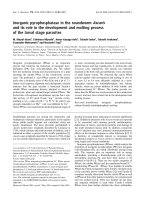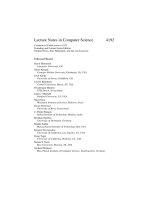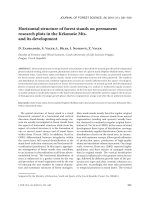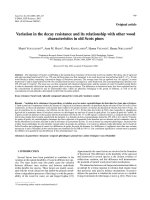RECENT ADVANCES IN THE PATHOGENESIS, PREVENTION AND MANAGEMENT OF TYPE 2 DIABETES AND ITS pptx
Bạn đang xem bản rút gọn của tài liệu. Xem và tải ngay bản đầy đủ của tài liệu tại đây (13.86 MB, 454 trang )
RECENT ADVANCES IN
THE PATHOGENESIS,
PREVENTION AND
MANAGEMENT OF
TYPE 2 DIABETES AND
ITS COMPLICATIONS
Edited by Mark B. Zimering
Recent Advances in the Pathogenesis, Prevention and
Management of Type 2 Diabetes and its Complications
Edited by Dr Mark B. Zimering
Published by InTech
Janeza Trdine 9, 51000 Rijeka, Croatia
Copyright © 2011 InTech
All chapters are Open Access articles distributed under the Creative Commons
Non Commercial Share Alike Attribution 3.0 license, which permits to copy,
distribute, transmit, and adapt the work in any medium, so long as the original
work is properly cited. After this work has been published by InTech, authors
have the right to republish it, in whole or part, in any publication of which they
are the author, and to make other personal use of the work. Any republication,
referencing or personal use of the work must explicitly identify the original source.
Statements and opinions expressed in the chapters are these of the individual contributors
and not necessarily those of the editors or publisher. No responsibility is accepted
for the accuracy of information contained in the published articles. The publisher
assumes no responsibility for any damage or injury to persons or property arising out
of the use of any materials, instructions, methods or ideas contained in the book.
Publishing Process Manager Mirna Cvijic
Technical Editor Teodora Smiljanic
Cover Designer Jan Hyrat
Image Copyright David Watkins, 2010. Used under license from Shutterstock.com
First published August, 2011
Printed in Croatia
A free online edition of this book is available at www.intechopen.com
Additional hard copies can be obtained from
Recent Advances in the Pathogenesis, Prevention and Management of Type 2 Diabetes
and its Complications, Edited by Mark B. Zimering
p. cm.
ISBN 978-953-307-597-6
free online editions of InTech
Books and Journals can be found at
www.intechopen.com
Contents
Preface IX
Part 1 Diabetic Neuropathy 1
Chapter 1 New Treatment Strategies in
Diabetic Neuropathy 3
Anders Björkman, Niels Thomsen and Lars Dahlin
Chapter 2 Sonographic Imaging of the Peripheral Nerves in Patients
with Type 2 Diabetes Mellitus 15
Tsuneo Watanabe, Shin-ichi Kawachi and Toshio Matsuoka
Chapter 3 Diabetic Neuropathy
– Nerve Morphology in the Upper Extremity 33
Niels Thomsen, Anders Bjorkman and Lars B. Dahlin
Part 2 Diabetes and Cardiovascular Disease 43
Chapter 4 Residual Vascular Risk in T2DM:
The Next Frontier 45
Michel P. Hermans, Sylvie A. Ahn and Michel F. Rousseau
Chapter 5 Type 2 Diabetes and Fibrinolysis 67
Ján Staško, Peter Chudý,
Daniela Kotuličová, Peter Galajda,
Marián Mokáň and Peter Kubisz
Chapter 6 Diabetes and Aspirin Resistance 91
Subhashini Yaturu and Shaker Mousa
Chapter 7 Diabetic Cardiomyopathy 105
Dike Bevis Ojji
Chapter 8 AF and Diabetes Prognosis and Predictors 119
Carlo Pappone, Francesca Zuffada and Vincenzo Santinelli
VI Contents
Chapter 9 Detection of Silent Ischemia in
Patients with Type 2 Diabetes 129
Babes Elena Emilia and Babes Victor Vlad
Chapter 10 Effects of Type 2 Diabetes on Arterial Endothelium 155
Arturo A. Arce-Esquivel, Aaron K. Bunker and M. Harold Laughlin
Part 3 Hypertension, Nephropathy and Diabetes 179
Chapter 11 Antihypertensive Treatment
in Type 2 Diabetic Patients 181
Angelo Michele Carella
Chapter 12 Managing Hypertension in Patients with Diabetes 207
Arthur L.M. Swislocki
and David Siegel
Chapter 13 Treatments for Hypertension in Type 2
Diabetes-Non-Pharmacological and
Pharmacological Measurements 233
Kazuko Masuo and Gavin W. Lambert
Chapter 14 Diabetic Nephropathy; Clinical Characteristics
and Treatment Approaches 263
Derun Taner Ertugrul, Emre Tutal and Siren Sezer
Chapter 15 Anemia of Chronic Kidney Disease in
Diabetic Patients: Pathophysiologic Insights
and Implications of Recent Clinical Trials 273
Victoria Forte, Miriam Kim, George Steuber,
Salma Asad and Samy I. McFarlane
Chapter 16 A Diachronic Study of Diabetic Nephropathy in
Two Autochthonous Lines of Rats to Understand
Diabetic Chronic Complications 283
Juan Carlos Picena, Silvana Marisa Montenegro,
Alberto Enrique D´Ottavio, María Cristina Tarrés
and Stella Maris Martínez
Part 4 Diverse Organ Involvement/Dysfunction in Diabetes 301
Chapter 17 Pathogenic Features of Insulin Resistance and Critical
Organ Damage in the Liver, Muscle and Lung 303
Kei Nakajima, Toshitaka Muneyuki,
Masafumi Siato and Masafumi Kakei
Chapter 18 Implications of Type II Diabetes Mellitus
on Gastrointestinal Cancers 323
Diana H. Yu and M. Mazen Jamal
Contents VII
Chapter 19 Prevention for Micro- and Macro-Vascular
Complications in Diabetic Patients 337
Kyuzi Kamoi
Part 5 Aspects of the Treatment of Type 2 Diabetes 373
Chapter 20 Emerging Challenge of Type 2 Diabetes:
Prospects of Medicinal Plants 375
Rokeya Begum, Mosihuzzaman M, Azad Khan AK,
Nilufar Nahar and Ali Liaquat
Chapter 21 Nutritional Therapy in Diabetes: Mediterranean Diet 391
Pablo Pérez-Martínez, Antonio García-Ríos, Javier Delgado-Lista,
Francisco Pérez-Jiménez and José López-Miranda
Chapter 22 Pharmacogenetics for T2DM and Anti-Diabetic Drugs 413
Qiong Huang and Zhao-qian Liu
Preface
Type 2 diabetes mellitus affects nearly 120 million persons worldwide- and according
to the World Health Organization this number is expected to double by the year 2030.
Owing to a rapidly increasing disease prevalence- the medical, social and economic
burdens associated with the microvascular and macrovascular complications of type 2
diabetes are likely to increase dramatically in the coming decades. In this volume,
leading contributors to the field review the pathogenesis, treatment and management
of type 2 diabetes and its complications. They provide invaluable insight and share
their discoveries about potentially important new techniques for the diagnosis,
treatment and prevention of diabetic complications.
Neuropathy is the most common microvascular complication in diabetes. In the Section
on Diabetic Neuropathy, Bjorkman et al. provide evidence for how a novel technique
known as ‘targeted plasticity’ may be useful for stimulating recovery of somatosensory
function in diabetic neuropathy affecting the hand. Watanabe and co-workers describe
the use of ultrasound of peripheral nerve as a potentially promising new modality for
the evaluation of patients having distal polyneuropathy. Thomsen et al summarize the
differences in nerve fiber morphology between large vs small fiber neuropathy.
Type 2 diabetes is associated with a two-four- fold increased risk for cardiovascular
disease. In the section Diabetes and Cardiovascular Disease, Hermans et al. review the
evidence supporting atherogenic dyslipidemia as a potentially important component
of residual vascular risk in diabetes. Stasko et al. treat the important topic of diabetes
and fibrinolysis, including evidence for plasminogen activator inhibitor-1 as a
predictor of cardiovascular risk in type 2 diabetes. Yaturu and Mousa discuss evidence
for aspirin resistance in diabetes. Ojji reviews the pathogenesis of diabetic
cardiomyopathy focusing on the unique contribution of diastolic dysfunction to heart
failure in diabetes. Pappone et al summarize the results of a large prospective
observational study in which type 2 diabetes was associated with an increased risk for
progression from paroxysmal to persistent atrial fibrillation. Silent ischemia is
highlighted in an excellent chapter by Emilia and Vlad Babes. Finally, Arce-Esquivel
and colleagues review the beneficial effects of exercise on endothelial function.
Hypertension frequently complicates type 2 diabetes contributing to a substantially
increased risk for cardiovascular disease or progression of nephropathy. In three
X Preface
excellent chapters written by Carella, Swislocki & Siegel, and Masuo & Lambert the
latest advances in treatment of hypertension in type 2 diabetes are summarized.
Ertugrul et al review treatment advances in diabetic nephropathy. MacFarlane and
colleagues summarize the management of chronic anemia in diabetic nephropathy.
Martinez et al describe a rat model which mimics certain key features of human
diabetic nephropathy which may be useful for improving understanding and
screening potential treatments to prevent this debilitating microvascular complication.
Diabetes is a multi-systemic disease which can affect many different target organs. In a
chapter by Nakajima et al, liver, muscle and lung involvement in diabetes are
reviewed with a focus on the association between diabetes and restrictive lung disease.
Diana Yu and Jamal Mohammad summarize evidence supporting an association
between type 2 diabetes and an increased risk for certain types of cancer affecting the
gastrointestinal tract. Kamoi summarizes evidence supporting the role for high blood
pressure and techniques for improving the predictive value of high blood pressure as
an important mediator of microvascular and macrovascular complications in diabetes.
Finally, three excellent chapters by Begum et al, Perez-Martinez et al, and Huang &
Liu informatively review aspects of the use of medicinal plants, nutritional therapy
and the pharmacogenetics of anti-diabetic drugs in the treatment of type 2 diabetes.
Mark B. Zimering, MD, PhD
Chief, Endocrinology
Veterans Affairs New Jersey Healthcare System
East Orange, New Jersey,
USA
Associate Professor of Medicine
University of Medicine and Dentistry of New Jersey/
Robert Wood Johnson Medical School, New Brunswick, New Jersey,
USA
Part 1
Diabetic Neuropathy
1
New Treatment Strategies in
Diabetic Neuropathy
Anders Björkman, Niels Thomsen and Lars Dahlin
Department of Hand Surgery, Skåne University Hospital, Lund University
Sweden
1. Introduction
Diabetes mellitus is associated with complications from a variety of tissues in the human
body. Among them, diabetic neuropathy is a devastating complication leading to severe
disability and even mortality. Neuropathy is common among type 1 and 2 diabetic patients
and may yet be detected at the time of diagnosis among type 2 diabetic patients. The
symptoms the patients experience vary from sensory disturbances with pain to muscle
wasting. The results of autonomic neuropathy should also be considered as a severe
problem in the patients, but will not be discussed in the present chapter.
The possibilities to treat diabetic neuropathy are limited and a strict glycaemic control has
mainly been advocated. The pathophysiology of diabetic neuropathy is complex and
includes e.g. biochemical disturbances and vascular factors. Of the former, the polyol
pathway has been the target for pharmacological attention. Based on the detailed
knowledge of the polyol pathway, obtained from experimental models and human studies,
that sorbitol accumulates in peripheral nerve trunks, pharmacological substances were
developed with the purpose to decrease sorbitol levels. Such aldose reductase inhibitors
have in different studies shown promising results (Bril et al., 2009; Hotta et al., 2008; Oates,
2008; Schemmel et al., 2010), but are still at a stage of development. Presently, various
strategies are emerging on the management of diabetic neuropathy, where it is stressed that
an appropriate diagnosis is crucial and that the condition is not untreatable (Perkins &
Krolewski, 2005). In the present chapter, we present a different approach than treatment
with pharmacological substances or focusing on the glycaemic level; namely, utilization of
the capacity of the brain to adapt to alterations. Thus, our intention is to use the plasticity of
the brain as a treatment strategy – i.e. targeted plasticity.
2. Peripheral neuropathy
A peripheral neuropathy in diabetes may affect both the upper and lower extremities, where
the latter location is more common and has gained more attention in research on diabetic
neuropathy. Up to 50% of patients with diabetes in the United States may have a neuropathy
in the lower extremity (Dyck et al., 1993). The prevalence of neuropathy in diabetes may vary
from different studies depending on which diabetic population is examined, e.g. differences in
Europe and Asia have been reported (Abbott et al., 2010; Rubino et al., 2007). In addition,
various techniques, such as electrophysiology, examination of vibrotactile sense, skin and
Recent Advances in the Pathogenesis, Prevention and
Management of Type 2 Diabetes and its Complications
4
nerve biopsies and monofilament tests, have been used to detect neuropathy in diabetes.
However, although the intense research over the years on various aspects of diabetic
neuropathy the mechanisms, which include biochemical and vascular components, behind the
different types of neuropathies in diabetes are not clarified. The pathophysiology of the
neuropathy is multifaceted and not completely elucidated, although peripheral nerve
dysfunction and established neuropathy in diabetes seem to be related to the degree of
hyperglycaemia (Lehtinen et al., 1989; Malik et al., 1993). Recently, some studies on diabetic
neuropathy with long term data on HbA1c levels available have not found any association
between glycaemic level and larger fibre neuropathy (vibrotactile sense) (Dahlin et al., 2011). A
specific issue in this context is if even impaired glucose tolerance can induce neuropathy, but
so far large myelinated nerve fibre neuropathy is probably not associated with impaired
glucose tolerance (Dahlin et al., 2008). However, reports indicate that small nerve fibre
dysfunction is present in patients with impaired glucose intolerance (Dahlin et al., 2008). The
latter condition and the question of possible presence of neuropathy is a complex issue and are
beyond the focus of the present chapter.
2.1 Diabetic foot ulcers
A particular problem in diabetes is the diabetic foot ulcer, which induces severe problems
for the patients (Bengtsson et al., 2008) and causes tremendous costs for society (Prompers et
al., 2008). It has long been known that diabetes may itself play an active part in the causation
of perforating foot ulcers (Londahl et al., 2010). Foot ulcers are common in diabetic patients
and associated with high morbidity and mortality. The prevalence of diabetic foot ulcer is
1.7 – 2.9% and the annual population based incidence among diabetic patients is 1.9 – 3.6%.
Interestingly, the annual incidence rates of foot ulcers in patients with diabetic neuropathy
vary from 5 to 7% (Abbott et al., 2010) and the recurrence rate is high. It is estimated that
70% of healed foot ulcers recur within five years (Apelqvist et al., 1993). It is generally
accepted that the majority of amputations in diabetes are preceded by foot ulcers on the
same leg with a lifetime risk of a foot ulcer estimated to reach 15-25%, where the majority of
the ulcers are located to the toes.
The main cause of diabetic foot ulcers are neuropathy and macro- and microvascular
disease, but also other factors may increase the risk for an ulceration (Londahl et al., 2010).
Patients with loss of sensation in the foot seem to have a sevenfold increased risk of
developing foot ulcers as compared to diabetic patients without neuropathy (Young &
Harris, 1994). In addition, a defect proprioception due to neuropathy may also cause
impaired balance and postural instability contributing to the risk for foot ulceration. In
clinical practice, sensory neuropathy is usually evaluated using monofilaments, 128 Hz tune
fork or biothesiometer, where the latter is considered to be the most appropriate method
(Edmonds, 2004). However, a multifrequency technique to examine vibrotactile sense has
not previously been used to evaluate neuropathy in the foot, particularly as related to the
risk for recurrence of foot ulcers. It may be an exiting approach in the future to refine
detection of neuropathy. Interestingly, adjunct hyperbaric oxygen therapy, used in a
multidisciplinary setting, can improve healing of chronic diabetic foot ulcers (Londahl et al.,
2010); a therapy that may also beneficial in nerve regeneration after injury.
2.2 Carpal tunnel syndrome in diabetes
Diabetic patients have an increased prevalence of one of the most common peripheral nerve
compression lesions, i.e. carpal tunnel syndrome (CTS), which is compression of the median
New Treatment Strategies in Diabetic Neuropathy
5
nerve at wrist level. It has a prevalence of 2-4% in the general population, while in diabetes
it may be as high as 15%. Furthermore, if the subject has diabetic neuropathy in the lower
extremity, the prevalence of CTS may approach 30% (Perkins et al., 2002). Interestingly, it
has been shown that there seems to be an increased general susceptibility to peripheral
nerve compression in diabetic rats (Dahlin et al., 2008), which can be related to disturbed
axonal transport and a propensity to inhibit such transport in compression of diabetic
nerves (Dahlin et al., 1987; Dahlin et al., 1986).
Previously, it has been stated that surgical release of the median nerve in the carpal tunnel
has no benefit for the patients and their symptoms from the CTS. Two previous studies
showed diverse results (Mondelli et al., 2004; Ozkul et al., 2002), and proper conclusions can
be difficult due to definition and selection of patients, extent of neuropathy and many other
factors. Recently, we presented a prospective study where the outcome after surgical release
of the carpal ligament was examined in diabetic patients with CTS and compared with age-
and gender-matched healthy patients with CTS. The overall conclusion was that diabetic
patients with CTS do benefit from surgical release of the carpal ligmament. This statement is
relevant irrespective of the severity of the compression lesion or if signs of peripheral
neuropathy are present (Thomsen et al., 2009). However, our data do not support a general
view that any peripheral nerve trunk in diabetic patients should be surgically released.
3. Introduction to brain plasticity
The brain has been seen as a rather static organ until about 20 years ago. It was widely
believed by neuroscientists that no new neural connections could be formed in the adult
brain (Kandel et al., 2000; Purves, 2004). It was assumed that once connections had been
established in foetal life, or in early infancy, they hardly changed later in life. This stability
of connections in the adult brain has often been used to explain why there is usually very
little functional recovery after damage to the nervous system. On the other hand, memory
and learning require that some changes are possible also in the adult brain (Kandel et al.,
2000). It has often been assumed that these phenomena are based on small changes at the
synaptic level and do not necessarily involve alterations in the basic circuit of the brain.
The picture has changed radically in the last decades. One of the most interesting questions
in neuroscience concerns the manner in which the nervous system can modify its
organisation and ultimately its function throughout an individuals lifetime based on
sensory input, experience, learning and injury (Donoghue, 1996; Kaas, 1991); a phenomenon
that is often referred to as brain plasticity (Kandel et al., 2000; Purves, 2004).
3.1 Plasticity in the adult somatosensory pathways
There is a complete somatotopic map of the entire body surface in the somatosensory cortex
of primates (Kaas et al., 1983; Merzenich et al., 1983). Merzenich et al (Merzenich et al., 1984)
showed that after amputation of the middle finger of adult primates, the area in the cortex
corresponding to the amputated digit began, within two months, to respond to touch
stimuli presented to the adjacent digits; i.e. this area is “taken over” by sensory input from
adjacent digits. Merzenich et al (Merzenich et al., 1984) also showed that if a monkey “used”
one finger excessively, for an hour and a half a day, then, after 3 months, the area of cortex
corresponding to that finger “expanded” at the expense of adjacent fingers. Furthermore, if
a monkey was forced to always use two fingers jointly by suturing two of its fingers
together, it was found at seven weeks that single neurons in area 3b in the primary
Recent Advances in the Pathogenesis, Prevention and
Management of Type 2 Diabetes and its Complications
6
somatosensory cortex had receptive fields that spanned the border separating the two digits.
Interestingly, if more than one finger was amputated there was no “take over” beyond
about 1 mm of cortex. Merzenich et al (Merzenich et al., 1987) concluded from this that the
expansion is probably mediated by arborisation of thalamo-cortical axons that typically do
not extend beyond 1 mm. The figure 1 mm has often been cited as the fixed upper limit of
reorganization of sensory pathways in adult animals (Calford, 1991). Pons et al (Pons et al.,
1991), however, suggested that this view might be incorrect. They found that after long-term
(12 years) deafferentation of an upper limb, the cortical area originally corresponding to the
hand in the primary somatosensory cortex was taken over by sensory input from the face.
The cells in “the cortical hand area” now started to respond to stimuli applied to the lower
face region. Since this patch of cortex is more than 1 cm wide, they concluded that sensory
reorganisation could occur over at least this distance, i.e. an order of magnitude ten times
greater than the original 1 mm limit.
In addition to these long-term changes that are typically seen weeks or months after
deprivation or stimulation, Calford and Tweelade (Calford, 1990) reported rapid, short term
changes that are based, presumably, on the unmasking of pre-existing connections rather
than on anatomical “sprouting”. They anaesthetized the middle finger of flying foxes and
found that within 20 minutes the cortical neurons in the primary somatosensory cortex that
originally responded to the middle finger could then be activated by touching the adjacent
digits, indicating that the receptive fields had expanded to include adjacent digits.
Calford and Tweedale (Calford, 1990) also showed that a small unilateral peripheral
denervation in adult flying foxes lead to expansion of the cortical receptive field for
neighboring skin areas as predicted from the work of Merzenich et al (Merzenich et al.,
1984).
Rapid plasticity changes are typically seen minutes after injury or an intervention, and are
often based on decreased inhibition. Decreased inhibition would theoretically increase the
receptive field size and enable more neurons to be activated by the stimulus. This is
sometimes referred to as unmasking of synapses or neural structures.
Surprisingly, the receptive field of the homotopic region in the other hemisphere mirrored
the change. In other words, the second hemisphere learned what the first had done; it
copied the revised sensory map. Maintaining symmetric sensory representation of the two
sides in the cerebral cortex may be important for the control of symmetric bilateral motor
activity.
Experience dependent plasticity refers to the ability of the adult brain to adjust itself to
changes in environmental conditions. It relates to the learning of special skills that requires
special training and it often requires motivation and concentration on the task.
Another example of brain plasticity is the so called cross-modal plasticity. This phenomenon
implies that one sensory modality can substitute for another (Bavelier & Neville, 2002). The
most well known example is in blind persons where an improved sensory function is
noticed. It has also been shown that when a blind person reads Braille activation in the
occipital lobe occurs implying that the somatosensory stimuli from reading activates the
cortical area responsible for vision (Gizewski et al., 2003).
Another example is persons in whom the lack of sensibility can be substituted with hearing.
Through small microphones on the fingers the persons can, after a short training period,
listen to what they feel (Lundborg et al., 1999). A crucial element in such cross-modal
plasticity seems to be training, in order for a sensory modality to “take over” another
sensory modality.
New Treatment Strategies in Diabetic Neuropathy
7
3.2 Mechanisms of plasticity
Several cellular mechanisms by which the adult brain can adjust to changes in the
environment or in sensory input have been defined, including the following (Kandel et al.,
2000; Purves, 2004).
Decreased inhibition
Many connections between the periphery and the cortex as well as intracortical connections
are physiologically “silent” because of inhibitory influences (Wall, 1977). Sensory
stimulation of a point on the skin activates neurons in the somatosensory system near the
centre of the area of cortical representation and inhibits activity in neurons near the edges.
In this way the receptive field appears smaller than its actual size. The inhibition is due to
activation of inhibitory interneurons near the edges of the receptive field. Decreased
inhibition would theoretically increase the receptive field size and enable more neurons to
be activated by the stimulus; this is sometimes referred to as unmasking of synapses or
neural structures. Gamma-aminobutyric acid (GABA) is the most important inhibitory
neurotransmittor in the brain (Jones, 1993) and evidence is strong that reduction of
GABAergic inhibition is crucial in mediating short term plasticity changes (Chen et al.,
2002).
Increase in synaptic strength
The effectiveness of synaptic connections is continuously adopted in response to functional
demands. Synaptic transmission becomes facilitated in a pathway that is frequently used,
while those that lay dormant atrophy. In this way, repeated practice of a task leads to
increased speed and accuracy of performance. Increased synaptic strength may be a
mechanism for learning and also for recovery from brain injury. Repetitive stimulation
results in increased excitability and facilitation of transmission in the synapses. These effects
persist for some time after the initial stimulus and subsequently show gradual declines (long
term potentiation, LTP). Calcium channels in the neuronal membrane appear to be crucial in
this process. LTP is probably one of the major mechanism by which learning and memory
consolidation takes place in the brain (Kandel et al., 2000).
Axonal and dendritic sprouting
The sprouting and elongation of new dendrites and axons is a common response to injury and
cell loss at all levels in the nervous system. Sprouting can also be seen in response to increased
functional demand, such as exposure to conditions requiring more complex motor activity
(Kleim et al., 1996). Axons at the edges of a lesion send new axonal branches into the damaged
area and re-innervate dendrites that have lost their synaptic input. This leads to new synaptic
formation at the point of contact of axonal sprouts with these dendritic trees. This mechanism
for recovery has been suggested in, for example, the reaction of the somatosensory cortex to
loss of its input from the skin (Merzenich et al., 1984; Pons et al., 1991).
3.3 Targeted plasticity
The primary somatosensory-and motorcortex is organized somatotopically, where different
body parts project to different parts of the primary somatosensory-and motor cortex (Figure
1). The somatotopic map does not represent the body in its actual proportions. Instead,
larger cortical areas are being assigned to sensitive parts or parts with complex motor
demands, such as the hands and face. The cortical representation of different body parts
alters constantly, depending on the pattern of afferent nerve impulses, injury and increased
or decreased use.
Recent Advances in the Pathogenesis, Prevention and
Management of Type 2 Diabetes and its Complications
8
Fig. 1. Sensory information is sent from, in this case, the hand via the peripheral nerve to the
dorsal root ganglia, spinal cord and thalamus to the primary somatosensory cortex. Motor
information is sent from the primary motor cortex to the spinal cord and the effector
muscles.
Both the primary somatosensory and motor cortex are arranged somatotopically. Thus in
each hemisphere there is a complete somatotopic map of the body both in the primary
somatosensory and motor cortex.
To utilize the central nervous systems’ (CNS) ability to change for therapeutic purposes,
guided plasticity is an attractive concept with promising results (Duffau, 2006). The
potential for cerebral plasticity is, for example, used in treatment of patients to strengthen or
promote CNS functions that are lost or weakened. The plastic potential of the brain might be
guided using neurosurgical methods, rehabilitation and different pharmacological drugs in
order to improve lost or damaged functions (Duffau, 2006). The use of neurosurgical
methods is very complicated, sometimes including complex surgical interventions, which
limit the usefulness. The use of potent drugs affecting the central nervous system, such as
amphetamine (Walker-Batson et al., 2001) and norepinephrine (Plewnia et al., 2004), in order
to improve recovery of damaged function, have been described. However, few patients
currently benefit from such treatments due to incomplete knowledge of optimal treatment
regimes and side effects from the drugs.
New Treatment Strategies in Diabetic Neuropathy
9
Our main objective when starting to develop a treatment regime for diabetic neuropathy
was to look for a method more suitable for patient usage, giving a cortical deafferentation
“large” enough to induce changes in peripheral function but not unnecessarily large. The
method should also be safe with no side effects, pain free, and easy to us for both patient
and therapist. Furthermore, it should be specific for sensory functions not affecting the
motor function as this would affect the person’s ability to perform motor tasks.
It is well known from animal and human experiments that temporary cutaneous anesthesia
of one body part leads to cortical re-organization resulting in a corresponding silent area in
the sensory cortex. This allows adjacent nearby body parts to rapidly expand at the expense
of the silent cortical area this is likely mediated by unmasking of existing synapses.
The forearm is located next to the hand in the somatotopic map and by anaesthetizing the
forearm, the cortical hand area can rapidly expand over the forearm area resulted in
improved sensory function of the hand in healthy controls (Bjorkman et al., 2009). Thus,
more nerve cells can be available for the hand, resulting in improved hand function. In a
randomized, controlled trial, sensory re-learning in combination with cutaneous forearm
anesthesia, using an anesthetic cream, EMLA® containing 2.5% lidocain and 2.5% prilokain,
improved sensory function of the hand compared with sensory re-learning and placebo in
patients with ulnar or median nerve repair (Rosen et al., 2006). The participants received
treatment twice a week for two consecutive weeks, and the effects lasted 4 weeks after the
last EMLA® treatment. These results suggest that sensory recovery is enhanced by
temporary anesthesia of adjacent body parts. The long lasting effect indicates that this
treatment is clinically useful and relevant.
Recently, the same principle of temporary cutaneous anesthesia as that used for the hand
has been applied on the foot in uninjured subjects. In a randomized controlled trial,
improvement in sensory function of the foot was observed after EMLA® treatment of the
lower leg compared to placebo (Rosen et al., 2009).
There is no specific treatment for neuropathy in diabetes except a strict control of the
glycaemic level. However, recent data in healthy subjects and diabetic patients show that
the sensory function in the foot and hand, measured by the monofilament test, can be
improved by using the central nervous systems ability to change, i.e. brain plasticity. In a
recent double blind randomized placebo controlled study male (n=26) or female (n=5)
diabetic patients with type 1 (n=30) or type 2 (n=7) with a median duration of diabetes of 35
years, all with insulin treated diabetes, were either treated with EMLA® cream or placebo
cream applied to the skin of the lower leg for 1.5 hours (n=18 and n=19, respectively). All
the subjects in the EMLA® group with pre-treatment diminished protective sensibility at the
first metatarsal head showed improved touch threshold below limits for protective
sensibility after 1.5 and 24 hours, while no such changes were observed after the treatment
with placebo cream (Fig 2).
Furthermore, the touch thresholds improved at four other assessment sites (third metatarsal
head, fifth metatarsal head, pulp of big toe and central of heal) together with increased
vibration threshold at 125 Hz. However, the patients observed no subjective improvement,
based on examination with a visual analogue scale, after treatment. This new strategy to
improve the thresholds of touch creates new possibilities to treat disturbances in sensation
of the diabetic foot. Hypothetically, the local anaesthetic cream results in a deafferentation of
the lower leg in the primary somatosensory cortex, which allows the foot to expand. Thus,
more nerve cells are available for the foot resulting in the observed improved sensory
function.
Recent Advances in the Pathogenesis, Prevention and
Management of Type 2 Diabetes and its Complications
10
A challenge is to create a long lasting improvement of the sensory function. Studies using
cutaneous anaesthesia in the upper extremity in patients with nerve injuries and neuropathy
have shown that a lasing improvement of sensibility is possible using repeated sessions with
cutaneous anaesthesia (Rosen et al., 2008; Rosen et al., 2006).
In conclusion, treatment of diabetic neuropathy is complicated. However, new knowledge
on the effect of a peripheral nerve injury and neuropathy on the central nervous system
opens new perspectives to treat neuropathy by targeted plasticity. Cutaneous anaesthesia of
the lower leg in diabetic patients is a good example of how targeted plasticity is used in
order to improve foot sensibility in patients with diabetic neuropathy. The method is
simple, safe, and cost-effective, although future studies are needed to work out the optimal
treatment regime for a long lasting or permanent improvement in sensibility.
Fig. 2. Change of touch threshold in first metatarsal head in diabetic patients between pre-
treatment and after 1.5 h of EMLA® treatment compared with placebo (P < 0.001).
4. Acknowledgement
The studies on diabetic neuropathy from our group was supported by the Swedish Research
Council (Medicine), Crafoord’s Fund for Medical Research, Svenska Diabetesförbundet,
Diabetesföreningen Malmö, Konsul Thure Carlsson Fund for Medical Research, Region
New Treatment Strategies in Diabetic Neuropathy
11
Skåne, Stiftelsen Sigurd och Elsa Goljes Minne and Funds from the University Hospital
Malmö, Sweden.
5. References
Abbott, CA., Chaturvedi, N., Malik, RA., Salgami, E., Yates, AP., Pemberton, PW., &
Boulton, AJ. (2010). Explanations for the lower rates of diabetic neuropathy in
Indian Asians versus Europeans. Diabetes Care, Vol. 33, No. 6, pp 1325-1330
Apelqvist, J., Larsson, J., & Agardh, C.D. (1993). Long-term prognosis for diabetic patients
with foot ulcers. Journal of Internal Medicine, Vol. 233, No. 6, pp 485-491
Bavelier, D., & Neville, HJ. (2002). Cross-modal plasticity: where and how? Nat Rev Neurosci,
Vol. 3, No. 6, pp 443-452
Bengtsson, L., Jonsson, M., & Apelqvist, J., (2008). Wound-related pain is underestimated in
patients with diabetic foot ulcers. Journal of Wound Care, Vol. 17, No. 10, pp 433-435
Bjorkman, A., Weibull, A., Rosen, B., Svensson, J., & Lundborg, G. (2009). Rapid cortical
reorganisation and improved sensitivity of the hand following cutaneous
anaesthesia of the forearm. European Journal of Neuroscience, Vol. 29, No. 4, pp 837-
844
Bril, V., Hirose, T., Tomioka, S., Buchanan, R., & Ranirestat Study Group. (2009). Ranirestat
for the management of diabetic sensorimotor polyneuropathy. Diabetes Care, Vol.
32, No. 7, pp 1256-1260
Calford, M. (1991). Neurobiology. Curious cortical change. Nature, Vol. 352, No. 6338, pp
759-760
Calford, MB., & Tweedale, R. (1990). Interhemispheric transfer of plasticity in the cerebral
cortex. Science, Vol. 249, pp 805-807
Chen, R., Cohen, LG., & Hallett, M. (2002). Nervous system reorganization following injury.
Neuroscience, Vol. 111, No. 4, pp 761-773
Dahlin, LB., Archer, DR., & McLean, WG. (1987). Treatment with an aldose reductase
inhibitor can reduce the susceptibility of fast axonal transport following nerve
compression in the streptozotocin-diabetic rat. Diabetologia, Vol. 30, pp 414-418
Dahlin, LB., Granberg, V., Rolandsson, O., Rosen, I., & Dahlin, E. (2011). Disturbed
vibrotactile sense in finger pulps in patients with type 1 diabetes – correlations with
glycaemic level, clinical examination and electrophysiology. Diabetic Medicine, Vol.
In press
Dahlin, LB., Meiri, KF., McLean, WG., Rydevik, B., & Sjöstrand, J. (1986). Effects of nerve
compression on fast axonal transport in streptozotocin-induced diabetes mellitus.
Diabetologia, Vol. 29, pp 181-185
Dahlin, LB., Thrainsdottir, S., Cederlund, R., Thomsen, NO., Eriksson, KF., Rosen, I.,
Speidel, T., & Sundqvist, G. (2008). Vibrotactile sense in median and ulnar nerve
innervated fingers of men with Type 2 diabetes, normal or impaired glucose
tolerance. Diabetic Medicine, Vol. 25, No. 5, pp 543-549
Donoghue, JP., Hess, G., & Sanes, JN. Motor cortical substrates and mechanisms for
learning. In: Bloedel JR, Ebner, T.J., Wise, S.P. (ed). Acquisition of Motor Behaviour in
Vertebrates. Cambridge, MA: MIT; 1996. pp. 363-386.
Duffau, H. (2006). Brain plasticity: from pathophysiological mechanisms to therapeutic
applications. J Clin Neurosci, Vol. 13, No. 9, pp 885-897
Recent Advances in the Pathogenesis, Prevention and
Management of Type 2 Diabetes and its Complications
12
Dyck, PJ., Kratz, KM., Karnes, JL., Litchy, WJ., Klein, R., Pach, JM., Wilson, DM., O'Brien,
PC.,
Melton, LJ., 3
rd
, & Service, FJ. (1993). The prevalence by staged severity of various types of
diabetic neuropathy, retinopathy, and nephropathy in a population-based cohort:
the Rochester Diabetic Neuropathy Study. Neurology, Vol. 43, No. 4, pp 817-824
Edmonds, ME, (2004). The diabetic foot, 2003. Diabetes/Metabolism Research and Reviews, Vol.
20 Suppl 1, pp S9-S12
Gizewski, ER., Gasser, T., de Greiff A., Boehm, A., & Forsting, M. (2003). Cross-modal
plasticity for sensory and motor activation patterns in blind subjects. Neuroimage,
Vol. 19, No. 3, pp 968-975
Hotta, N., Kawamori, R., Atsumi, Y., Baba, M., Kishikawa, H., Nakamura, J., Oikawa, S.,
Yamada, N., Yasuda, H., & Shigeta, Y.; ADCT Study Group. (2008). Stratified
analyses for selecting appropriate target patients with diabetic peripheral
neuropathy for long-term treatment with an aldose reductase inhibitor, epalrestat.
Diabetic Medicine, Vol. 25, No. 7, pp 818-825
Jones, EG. (1993). GABAergic neurons and their role in cortical plasticity in primates.
Cerebral Cortex, Vol. 3, No. 5, pp 361-372
Kaas, J. (1991). Plasticity of sensory and motor maps in adult mammals. Ann Rev neurosci,
Vol. 14, pp 137-168.
Kaas, JH., Merzenich, MM., Killackey, HP. (1983). The reorganization of somatosensory
cortex following peripheral nerve damage in adult and developing mammals.
Annual Review of Neuroscience, Vol. 6, pp 325-356
Kandel, ER., Schwartz, JH., & Jessel, TM. Principles of neural science. McGraw-Hill; 2000.
Kleim JA, Lussnig E, Schwarz ER et al., (1996). Synaptogenesis and Fos expression in the
motor cortex of the adult rat after motor skill learning. Journal of Neuroscience, Vol.
16, No. 14, pp 4529-4535
Lehtinen, JM., Uusitupa, M., Siitonen, O. & Pyorala, K. (1989). Prevalence of neuropathy in
newly diagnosed NIDDM and nondiabetic control subjects. Diabetes, Vol. 38, No.
10, pp 1307-1313
Londahl, M., Katzman, P., Hammarlund, C., Nilsson, A., & Landin-Olsson, M. (2010).
Relationship between ulcer healing after hyperbaric oxygen therapy and
transcutaneous oximetry, toe blood pressure and ankle-brachial index in patients
with diabetes and chronic foot ulcers. Diabetologia, Vol. 54, No. 1, pp 65-68
Lundborg, G., Rosén, B., & Lindberg, S. (1999). Hearing as substitution for sensation - a new
principle for artificial sensibility. J Hand Surg, Vol. 24A, pp 219-224
Malik, RA., Tesfaye, S., Thompson, SD., Veves, A., Sharma, AK., Boulton, AJ., & Ward, JD.
(1993). Endoneurial localisation of microvascular damage in human diabetic
neuropathy. Diabetologia, Vol. 36, No. 5, pp 454-459
Merzenich, MM., Kaas, JH., Wall, RJ., Nelson, M., Sur, D., & Felleman, D. (1983).
Topographic reorganization of somatosensory cortical areas 3B and 1 in adult
monkeys following restricted deafferentation. Neuroscience, Vol. 8, pp 33-55
Merzenich, MM., Nelson, RJ., KaasJH., Stryker, MP., Jenkins, WM., Zook, JM., Cynader, MS.,
& Schoppmann, A. (1987). Variability in hand surface representations in areas 3 b
and 1 in adult own and squirrel monkeys. Journal of Comparative Neurology, Vol. 258,
pp 281-297
New Treatment Strategies in Diabetic Neuropathy
13
Merzenich, MM., Nelson, RJ., Stryker, MS., Cynader, MS., Schoppmann, A., & Zook, JM.
(1984). Somatosensory cortical map changes following digit amputation in adult
monkeys. Journal of Comparative Neurology, Vol. 224, pp 591-605
Mondelli, M., Padua, L., Reale, F., Signorini, AM., & Romano, C. (2004). Outcome of surgical
release among diabetics with carpal tunnel syndrome. Archives of Physical Medicine
and Rehabilitation, Vol. 85, No. 1, pp 7-13
Oates, PJ. (2008). Aldose reductase, still a compelling target for diabetic neuropathy. Curr
Drug Targets, Vol. 9, No. 1, pp 14-36,1873-5592 (Electronic) 1389-4501 (Linking).
Ozkul, Y., Sabuncu, T., Kocabey, Y., & Nazligul, Y. (2002). Outcomes of carpal tunnel release
in diabetic and non-diabetic patients. Acta Neurologica Scandinavica, Vol. 106, No. 3,
pp 168-172
Perkins, BA., & Krolewski, AS. (2005). Early nephropathy in type 1 diabetes: a new
perspective on who will and who will not progress. Curr Diab Rep, Vol. 5, No. 6, pp
455-463,
Perkins, BA., Olaleye, D., & Brilm, V. (2002). Carpal tunnel syndrome in patients with
diabetic polyneuropathy. Diabetes Care, Vol. 25, No. 3, pp 565-569
Plewnia, C., Hoppe, J., Cohen, LG., & Gerloff, C. (2004). Improved motor skill acquisition
after selective stimulation of central norepinephrine. Neurology, Vol. 62, No. 11, pp
2124-2126
Pons, T., Preston, E., & Garraghty K, (1991). Massive cortical reorganization after sensory
deafferentation in adult macaques. Science, Vol. 252, pp 1857-1860
Prompers, L., Huijberts, M., Schaper, N., Apelqvist, J., Bakker, K., Edmonds, M., Holstein, P.,
Jude, E., Jirkovska, A., Mauricio, D., Piaggesi, A., Reike, H., Spraul, M., Van Acker,
K., Van Baal, S., Van Merode, F., Uccioli, L., Urbancic, V., & Ragnarson Tennvall, G.
(2008). Resource utilisation and costs associated with the treatment of diabetic foot
ulcers. Prospective data from the Eurodiale Study. Diabetologia, Vol. 51, No. 10, pp
1826-1834
Purves, D., Augustine, GJ., Fitzpatrick, D., Hall, WC., La Mantia AS., McNamara JO., &
Williams SM. Neuroscience (Sinauer Associates Inc. Sunderland, MA, USA, third
edition). 2004.
Rosen, B., Bjorkman A, & Lundborg G, (2008). Improved hand function in a dental hygienist
with neuropathy induced by vibration and compression: The effect of cutaneous
anaesthetic treatment of the forearm. Scandinavian Journal of Plastic and
Reconstructive Surgery and Hand Surgery, Vol. 42, No. 1, pp 51-53
Rosen, B., Bjorkman, A., & Lundborg, G. (2006). Improved sensory relearning after nerve
repair induced by selective temporary anaesthesia - a new concept in hand
rehabilitation. Journal of Hand Surgery British Volume, Vol. 31, No. 2, pp 126-132
Rosen, B., Bjorkman, A., Weibull, A., Svensson, J., & Lundborg, G. (2009). Improved
sensibility of the foot after temporary cutaneous anesthesia of the lower leg.
Neuroreport, Vol. 20, No. 1, pp 37-41
Rubino, A., Rousculp, MD., Davis, K., Wang, J., Bastyr, EJ., & Tesfaye, S. (2007). Diagnosis of
diabetic peripheral neuropathy among patients with type 1 and type 2 diabetes in
France, Italy, Spain, and the United Kingdom. Prim Care Diabetes, Vol. 1, No. 3, pp
129-134









